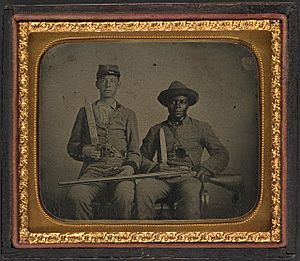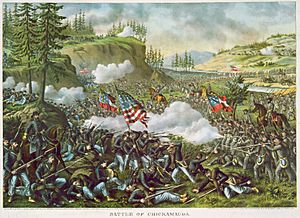Silas Chandler facts for kids
Quick facts for kids
Silas Chandler
|
|
|---|---|

Sergeant A.M. Chandler of the 44th Mississippi Infantry Regiment, Co. F., and Silas Chandler, family slave
|
|
| Born | 1838 Virginia, U.S.
|
| Died | September 1919 (aged 82) |
| Nationality | American |
| Occupation | Carpenter |
| Spouse(s) | Lucy Garvin |
| Children | 12 |
Silas Chandler (1838 – September 1919) was an African American man who was enslaved. He went with his owners, Andrew and Benjamin Chandler, when they joined the Confederate Army during the American Civil War. He was called a "manservant" during this time. Silas was also a skilled carpenter. After the war, he helped start and build the first Black church in his hometown of West Point, Mississippi.
Contents
Silas Chandler's Early Life
Silas was born in 1838 on a large farm in Virginia. When he was about two years old, his owner's family moved to Mississippi. They settled near the towns of Palo Alto, Mississippi and West Point, Mississippi. Silas learned the trade of carpentry, which is building things with wood. Around 1860, he married Lucy Garvin. At that time, laws in Mississippi did not officially recognize marriages between enslaved people.
Silas Chandler During the Civil War
When the American Civil War began, the Chandler family owned 36 enslaved people. Silas was sent to serve Andrew Chandler, who joined a group called the Palo Alto Confederates. This group later became part of the 44th Mississippi Infantry.
In 1861, Silas and Andrew were photographed together. They were both armed and wearing Confederate uniforms. Silas held a rifle, and both men had large knives. They also had pistols tucked into their clothes. Most of these weapons were likely props used by the photographer. During the war, Silas helped Andrew by carrying messages between him and his family.
When Andrew was captured in the Battle of Shiloh, he worried that Silas would also be caught. He feared Silas might be sent North and become free.
In 1863, Andrew Chandler was shot in the leg during the Battle of Chickamauga in Tennessee. Many soldiers in his group were killed or hurt in this battle. The army doctor wanted to cut off Andrew's leg. Silas may have used a special gold coin he kept for emergencies. He might have used it to buy whiskey to convince the doctor to let him take Andrew away. Silas then secretly helped Andrew get onto a train car to Atlanta. There, they met Andrew's uncle, who took them home.
Another story says Andrew's uncle bought the whiskey. No matter who bought it, Silas was very important in getting Andrew to Atlanta. This saved Andrew's leg, though it never fully recovered. After this, Silas was sent back to the war front. He then served Andrew's younger brother, Benjamin Chandler, in the 9th Mississippi Cavalry.
Silas was with Benjamin Chandler when Benjamin was part of a group guarding Confederate President Jefferson Davis. This was when Davis was fleeing from Richmond, Virginia. On May 7, 1865, Benjamin's group was told to break up. This was to make Davis's escape less noticeable as the Confederacy was falling apart.
Some of the Chandler family later said that Silas's actions showed his loyalty to them. However, others believe Silas stayed because he wanted to keep in touch with his wife. His first son, William Henry, was born during the war.
Life After the War
After the war ended, Silas returned to West Point. Silas and Lucy had 12 children together. Eight of them lived to adulthood: William Henry, Clarence Rufus, Charlie, Robert E., George, Mamie, Willie B., and Sarah. Silas continued his work as a carpenter. He taught his sons the trade, and his family helped build many homes, churches, banks, and other buildings in their town and across the state.
In 1868, Silas and other freedmen (people who had been enslaved and were now free) started the Mount Hermon Baptist Church. Silas bought the land next to his home and donated it for the church.
In 1916, Silas Chandler asked for a pension, which is money paid regularly. His application described him as a servant, not a soldier. Andrew Chandler spoke as a witness to support Silas's request. Silas died in September 1919, at the age of 82. His former owners, Benjamin and Andrew, died in 1909 and 1920.
Silas Chandler's Legacy
People have long been interested in the relationship between Silas and Andrew. They also wonder about Silas's role during the Civil War. In 1949, a newspaper article in West Point, Mississippi, showed the famous photo of Silas and Andrew. The article called Silas a slave, not a soldier.
However, by the 1990s, a descendant of Silas named Bobbie Chandler thought Silas might have been a soldier. This idea grew in popularity. In 1994, two groups, the Sons of Confederate Veterans and the United Daughters of the Confederacy, placed a metal cross at Silas's grave. They did this to honor him as a Confederate soldier.
The photo of Silas and Andrew was used in a Washington Times story in the early 1990s. Bobbie Chandler, who worked for the newspaper, shared a copy of the photo. After the 1994 ceremony, stories about Black Confederate soldiers became very popular. These stories were sometimes used to defend showing Confederate symbols in public places.
In 2010, Andrew Chandler Battaile, Jr., a descendant of Andrew Chandler, had the original photo valued on the TV show Antiques Roadshow. Later, the story of Andrew and Silas was shown on the TV show History Detectives. For many years, pro-Confederate websites sold items with the pair's image. They were often used as an example of Black Confederate soldiers.
However, descendants of both Andrew and Silas Chandler have now agreed that Silas was enslaved and not a soldier. Because of this, the Confederate honors at Silas's grave have been removed.



